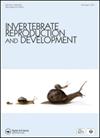Sexual size dimorphism of the freshwater shrimp Macrobrachium jelskii (Miers, 1877) (Decapoda: Palaemonidae) and its relationship to Rensch’s rule
IF 0.8
4区 生物学
Q4 REPRODUCTIVE BIOLOGY
引用次数: 5
Abstract
ABSTRACT Rensch’s rule attempts to explain the evolutionary processes that have resulted in the current patterns of sexual size dimorphism of several taxa. This rule predicts that sexual size dimorphism increases according to the average body size, when males are larger, decreasing when females are the largest sex. In decapod crustaceans, the general pattern of sexual size dimorphism is males with hypertrophied structures used in agonistic disputes, and females with a greater expansion of the abdominal chamber. We analyzed sexual size dimorphism of the freshwater shrimp Macrobrachium jelskii and its relationship to Rensch’s rule, as well as the relative growth between the sexes, for subpopulations from the Rosário reservoir in Ceará state, Brazil. The results of sexual size dimorphism show that females are morphometrically larger than males. Such a pattern of sexual dimorphism probably results from the selection of female fecundity, giving them greatest fecundity. This pattern indicates a female-biased SSD for this species, supported by what is proposed in Rensch’s rule. In the relative growth analysis, the males and females showed negative allometry of the cheliped. The absence of cheliped hypertrophy in males may indicate the presence of ‘pure-search’ reproductive behaviour, thus, no agonistic disputes for females.jelskii沼虾(Miers,1877)(十足目:Palaemonidae)的性别大小二型性及其与Rensch规则的关系
摘要Rensch规则试图解释导致目前几个分类群性别大小二态性模式的进化过程。这条规则预测,当雄性较大时,性别大小二型性会随着平均体型的增加而增加,当雌性最大时,性别尺寸二型性就会减少。在十足目甲壳类动物中,性别大小异形的一般模式是雄性具有用于痛苦纠纷的肥大结构,而雌性具有更大的腹腔扩张。我们分析了来自巴西塞阿拉州Rosário水库的淡水虾Macrobrachium jelskii的性别大小二型性及其与Rensch规则的关系,以及性别之间的相对生长。两性大小异形的结果表明,雌性在形态上比雄性大。这种两性异形模式可能是对雌性生殖力的选择,赋予它们最大的生殖力。这种模式表明该物种的SSD偏向雌性,这得到了Rensch规则中提出的支持。在相对生长分析中,雄性和雌性表现出螯肢的负异速。雄性没有螯足肥大可能表明存在“纯粹的搜索”生殖行为,因此,雌性没有痛苦的争议。
本文章由计算机程序翻译,如有差异,请以英文原文为准。
求助全文
约1分钟内获得全文
求助全文
来源期刊
CiteScore
1.90
自引率
0.00%
发文量
21
审稿时长
>12 weeks
期刊介绍:
Invertebrate Reproduction & Development ( IRD) presents original research on the reproductive and developmental biology of the Invertebrata, both embryonic and postembryonic. IRD welcomes papers reporting significant results obtained using new techniques. Encouraged topic areas include: aquaculture, physiology, biochemistry, functional morphology, phylogeny, behavioural and regulatory mechanisms, including genetic, endocrine and molecular studies. Papers containing qualitative descriptions of reproductive cycles and gametogenesis will not be considered. IRD is published in association with the International Society of Invertebrate Reproduction and Development.

 求助内容:
求助内容: 应助结果提醒方式:
应助结果提醒方式:


